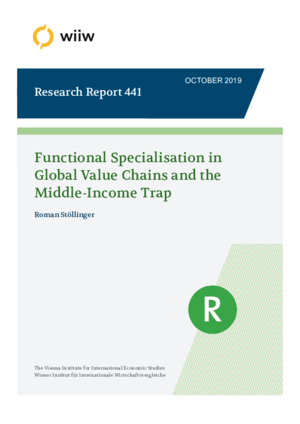Functional Specialisation in Global Value Chains and the Middle-Income Trap
wiiw Research Report No. 441, October 2019
27 pages including 5 Tables and 4 Figures
The emergence of global value chains (GVCs) has opened up the possibility of functional specialisation as a new dimension of the international dimension of labour. Along with the usual gains from trade associated with specialisation according to comparative advantages, the functional specialisation along value chains functions also reinforce technological asymmetries within the world economy. This paper presents empirical evidence on this asymmetry confirming that developing countries serve primarily as ‘factory economies’ while developed countries take the role of ‘headquarter economies’ (Baldwin, 2013). The concept of the ‘smile curve’ suggests that factory economies generate comparatively little value added in their value chain activities. If this is the case, the specialisation as a factory can be expected to act as a drag on economic growth. Our econometric analysis shows that this is indeed true but only beyond a GDP per capita threshold of about USD 14,800. We see this result tightly connected to the notion of a functional middle-income trap. Escaping this growth trap is difficult but by no means impossible and requires countries to adjust their functional specialisation patterns towards more knowledge-intensive value chain functions, especially in the knowledge-intensive pre-production activities.
Disclaimer:
Research for this paper was financed by the Anniversary Fund of the Oesterreichische Nationalbank (Project No. 17665). Support provided by Oesterreichische Nationalbank for this research is gratefully acknowledged.
Keywords: functional specialisation, global value chains, smile curve, economic growth
JEL classification: F60, L23, F20, F43
Research Areas: Macroeconomic Analysis and Policy, International Trade, Competitiveness and FDI
